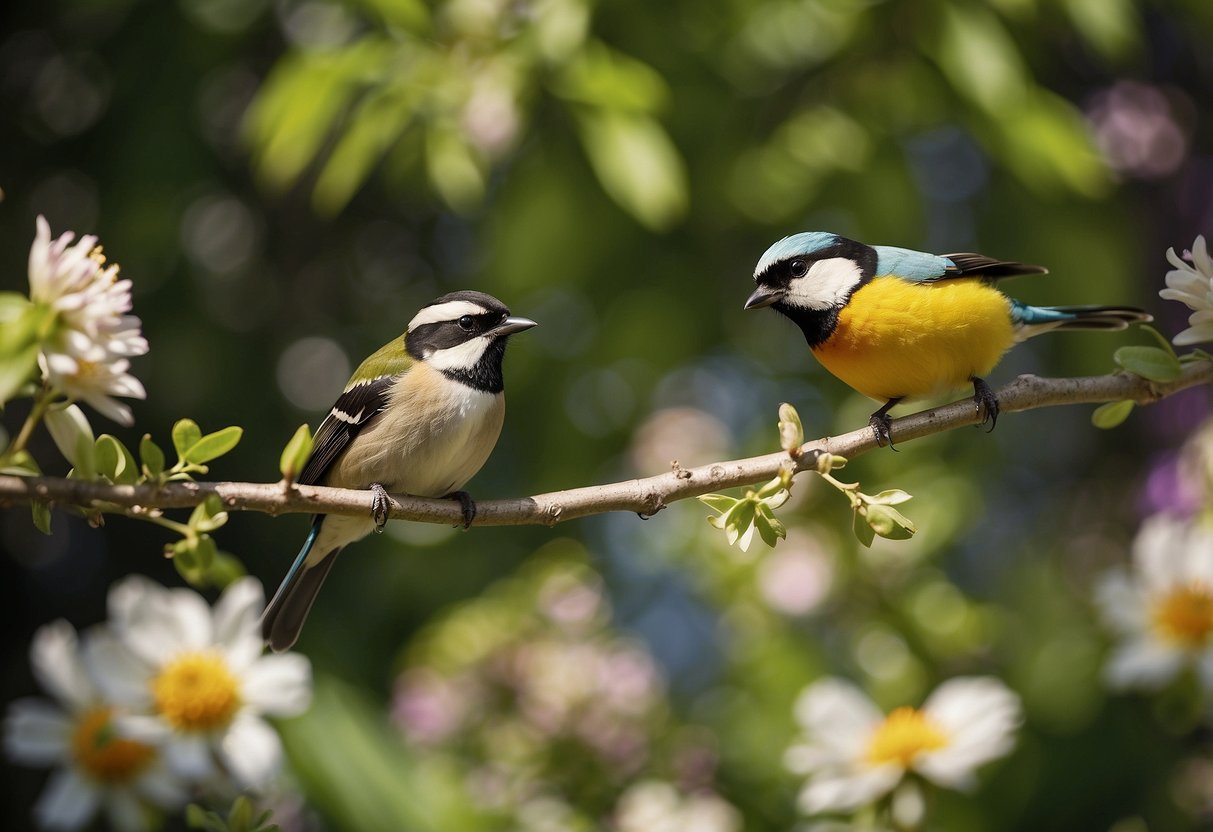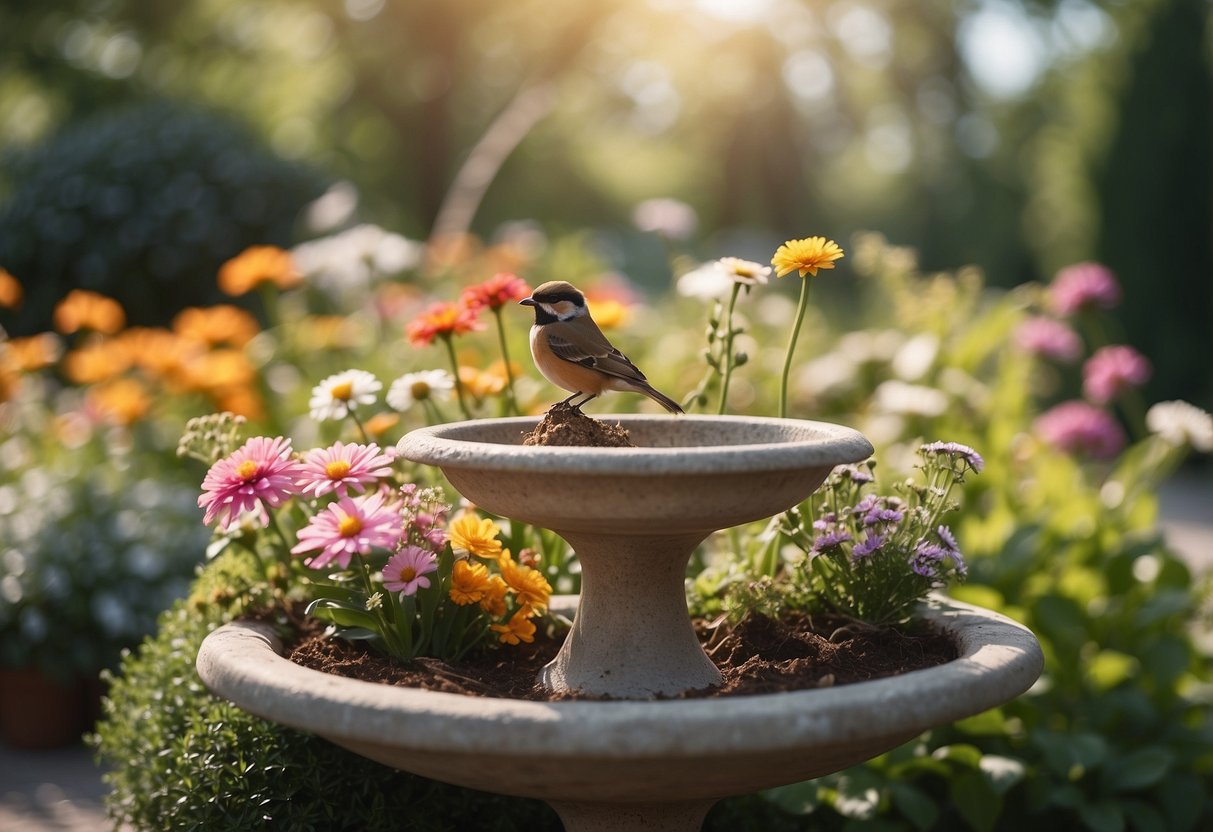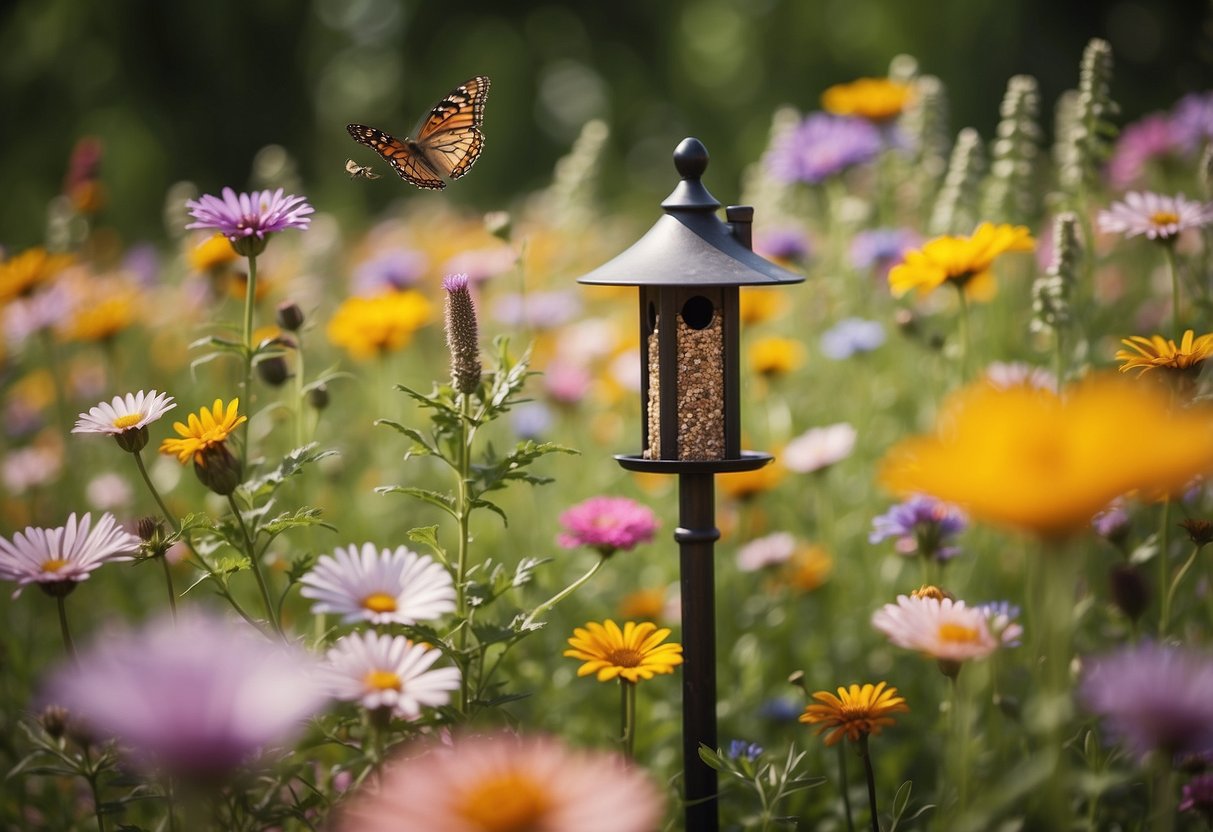Bird Garden Ideas: Create a Feathered Paradise
Creating a bird-friendly garden can transform your outdoor space into a vibrant haven for wildlife. Whether you are a seasoned gardener or just starting out, attracting various bird species adds color and life to your yard.

What are the best ways to design a garden that invites birds to visit? By selecting the right plants and features, you can draw in many different types of birds, providing them with food, shelter, and nesting sites. Engaging with nature this way can be both rewarding and fun, making your garden a peaceful retreat for both you and your feathered friends.
1) Birdhouses with Feeders

You can make your garden a haven for birds by combining birdhouses with feeders. These two-in-one setups not only provide a place for birds to nest but also offer easy access to food.
Choose designs that include large feeding platforms. This makes it easier for birds to find food and feel secure.
Opt for materials like cedar which are durable and look nice. For a creative twist, consider a themed birdhouse, like the Cedar TARDIS Doctor Who Bird House, to add some personality to your garden.
2) Butterfly-Friendly Plants

If you want your garden to attract butterflies, try planting butterfly weed and bee balm. These perennials are rich in nectar and will keep butterflies coming back.
Catmint and aster are also great choices. They bloom all summer and provide essential nectar, pollen, and seeds for butterflies.
Adding these plants to your garden can create a vibrant, butterfly-friendly space. Consider including a small birdhouse, too, as some butterflies may also appreciate the added shelter. For more tips, visit this guide on bird and butterfly garden plans.
3) Water Features with Bubblers

Adding a bubbler water feature to your garden can attract a variety of birds. The gentle bubbling sound entices birds to come, drink, and bathe.
These features not only provide water but also help keep the water moving. This movement prevents mosquitoes from breeding. Bubblers can be easily added to any pond or garden pool.
They are simple to install and maintain. With a little planning and creativity, you can create a peaceful spot that both you and the birds will love.
4) Hummingbird Feeders

Making your own hummingbird feeders can be fun and easy. You can turn a plastic bottle into a feeder by cutting holes for feeding ports and adding perches. Fill it with homemade nectar.
Another idea is using a SOLO cup. Cut holes in the cup’s sides so hummingbirds can access the nectar. Use string to hang it from a tree.
For a more decorative look, attach foam shapes and straws to a plastic bottle. Secure it with a string to hang.
Check out these DIY feeder ideas to create a welcoming space for hummingbirds in your garden.
5) Wildflower Meadow Corners

Creating wildflower meadow corners in your garden can attract a variety of birds and other wildlife. These areas are easy to maintain and offer a beautiful display of colors throughout the seasons.
Plant native wildflowers and grasses to provide food and shelter. Flowers like purple coneflower and butterfly weed are great choices.
Leave parts of your garden to grow wild for the best results. This helps birds, bees, and butterflies find a natural habitat. Learn more about creating wildflower garden ideas for inspiration.
6) Native Plants for Birds

Milkweed plants are great for attracting many insects, which birds love to eat. Some birds even use the fibers from milkweed to build their nests.
Sunflowers are another excellent choice. The seeds are a favorite among many bird species, acting like natural bird feeders.
Wild grapevines can provide a feast for birds like thrushes, grosbeaks, and orioles, especially in late summer and fall.
Planting these native species can not only beautify your garden but also create a welcoming habitat for your feathered friends. Try adding some of these plants to your space and enjoy the bird activity they bring.
7) Bird Nesting Boxes

Adding bird nesting boxes to your garden is a great way to attract birds and give them a safe place to raise their young.
Place the boxes in a quiet, sheltered spot away from predators.
Make sure the entrance hole is the right size for the birds you want to attract, like House Sparrows.
Keep the boxes clean to prevent disease and make them inviting for the birds. This small addition can make a big difference in your bird-friendly garden.
8) Fruit-Bearing Shrubs

Adding fruit-bearing shrubs to your garden is a great way to attract birds. These plants offer birds a ready food source, especially in the colder months.
Winterberry, for example, attracts mockingbirds and robins with its bright red berries in late fall. Just make sure you have both male and female plants for it to produce berries.
Serviceberry is another excellent choice. This small tree draws a variety of birds like orioles and thrushes with its tasty fruits.
Consider planting viburnum shrubs, too. They come in different sizes and produce colorful berries that birds love.
By choosing these shrubs, you’ll help make your garden a bird-friendly haven.
9) Herb Gardens for Birds

Creating an herb garden is a great way to attract birds to your yard. Herbs like sage, dill, and fennel provide food and shelter.
Planting lavender and thyme can offer nectar for birds and their insect prey. Birds love the seeds from basil and dill plants.
Include a small birdhouse among the herbs to provide a nesting spot. These plants are beautiful and functional, making your garden a bird haven.
10) Insect Hotels

Insect hotels are a fantastic addition to your bird garden. They offer a cozy space for beneficial insects like ladybugs, solitary bees, and lacewings.
To get started, build a frame using wood, stone, or brick. You can even use reclaimed materials like old pallets.
Fill the frame with natural items such as twigs, bark, grass, and leaves. Make sure to create small crevices for insects to hide.
Place your insect hotel in a sunny, dry spot in your garden. This will attract more insects and make it a welcoming home for them. This can boost local biodiversity in your garden.
Understanding Bird Behavior

Bird behavior is essential to creating a garden that attracts and supports various bird species. By understanding their habits and needs, you can create a more inviting space.
Types Of Birds Attracted To Gardens
Different types of birds have various preferences. Common backyard birds include sparrows, finches, and robins. Sparrows are often seen hopping on the ground looking for seeds. Finches love to visit bird feeders filled with small seeds like sunflower or thistle.
Robins, on the other hand, prefer open spaces with a lot of grass where they can find worms and insects. These behaviors can help you pick the right plants and features for your garden, ensuring you attract a diverse bird population. Including larger shrubs or trees will create shelter, attracting even more species.
Seasonal Behavior And Migration Patterns
Birds exhibit distinctive behaviors during different seasons. In spring, many birds are busy building nests and searching for food. Summer brings more feeding activity as they care for their young. You might notice that some birds, like hummingbirds, are more active early in the morning and late in the evening.
During fall, birds like warblers and orioles migrate to warmer areas. Setting up your garden with plants that produce fruit or seeds in autumn can support these migrating birds. In winter, non-migrating birds such as cardinals and woodpeckers rely on bird feeders and evergreen plants for food and shelter.
Creating a garden that caters to these behaviors will provide a year-round sanctuary for various bird species.
Creating A Bird-Friendly Environment

To create a bird-friendly environment in your garden, you need to focus on selecting the right plants, providing constant water sources, and setting up bird feeders and nesting boxes.
Choosing The Right Plants And Trees
Pick plants that offer birds food and shelter. Native plants are the best because they match the local birds’ needs. For example, a crabapple tree has edible fruit and fragrant flowers that birds love. Shrubs like hollies and serviceberries can provide berries and shelter throughout the year.
Also, avoid using pesticides. Birds can be harmed by them, and they reduce insect availability, which birds need for feeding. Plant layers of vegetation, including ground cover, shrubs, and trees, to create a diverse habitat.
Providing Water Sources
Birds need water for drinking and bathing. Installing a birdbath is a simple way to meet this need. Ensure it’s shallow with a gradual slope, so small birds can use it easily. Keeping it clean is essential to prevent diseases.
You can also add a small pond or water feature. Moving water will attract more birds; consider adding a fountain or dripper. In winter, heaters for birdbaths will ensure that water remains accessible even during freezing weather.
Using Bird Feeders And Nesting Boxes
Different birds prefer different feeders. Tube feeders are good for small birds like finches, while platform feeders can attract larger species. Suet feeders provide high-energy food for woodpeckers and other insect-eating birds.
Place feeders near shrubs or trees to offer birds cover from predators. Clean feeders regularly to prevent disease. Nesting boxes can attract birds that don’t usually nest in gardens. Ensure they match species’ needs—proper entrance hole size and placement are crucial.
Use nesting materials like small twigs and dried grass nearby. Secure boxes from predators and check them at the end of the season for cleaning.







